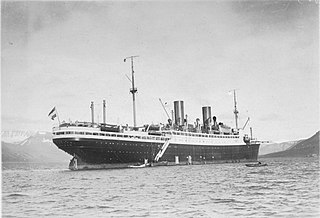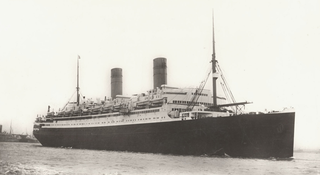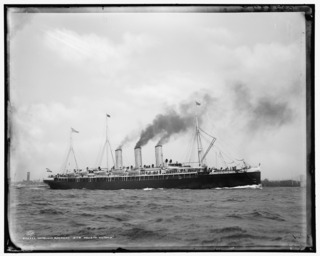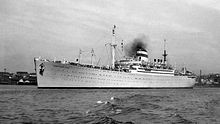
SS General von Steuben was a German passenger liner and later an armed transport ship of the German Navy that was sunk in the Baltic Sea during World War II. She was launched in 1923 as München, renamed General von Steuben in 1930, and renamed Steuben in 1938.

An ocean liner is a type of passenger ship primarily used for transportation across seas or oceans. Ocean liners may also carry cargo or mail, and may sometimes be used for other purposes. The Queen Mary 2 is the only ocean liner still in service to this day.
Holland America Line N.V. (HAL) is an American-owned cruise line, a subsidiary of Carnival Corporation & plc headquartered in Seattle, Washington, United States.
The Wigham Richardson shipbuilding company was named after its founder, John Wigham Richardson (1837-1908), the son of Edward Richardson, a tanner from Newcastle upon Tyne, and Jane Wigham from Edinburgh.

SS Deutschland was a 21,046 gross registered ton (GRT) German ocean liner of the HAPAG line. It was sunk in a British air attack on May 3, 1945.

USS Comfort (AH-3) was a hospital ship for the United States Navy in World War I. She was the sister ship of USS Mercy (AH-4) but the two ships were not of a ship class. Comfort was known as SS Havana in passenger service for the Ward Line, and as USAT Havana in United States Army service before her Navy service. Her name was restored to Havana in 1927, and she was renamed SS Yucatán in 1935, and SS Agwileon in 1941. In World War II, she was known as USAT Agwileon and USAHS Shamrock in service for the United States Army.

The Hamburg-Amerikanische Packetfahrt-Actien-Gesellschaft (HAPAG), known in English as the Hamburg America Line, was a transatlantic shipping enterprise established in Hamburg, in 1847. Among those involved in its development were prominent citizens such as Albert Ballin, Adolph Godeffroy, Ferdinand Laeisz, Carl Woermann, August Bolten, and others, and its main financial backers were Berenberg Bank and H. J. Merck & Co. It soon developed into the largest German, and at times the world's largest, shipping company, serving the market created by German immigration to the United States and later, immigration from Eastern Europe. On 1 September 1970, after 123 years of independent existence, HAPAG merged with the Bremen-based North German Lloyd to form Hapag-Lloyd AG.

RMS Majestic was a British ocean liner working on the White Star Line’s North Atlantic run, originally launched in 1914 as the Hamburg America Liner SS Bismarck. At 56,551 gross register tons, she was the largest ship ever operated by the White Star Line under its own flag and the largest ship in the world until completion of SS Normandie in 1935.

SMS Wolf was an armed merchant raider or auxiliary cruiser of the Imperial German Navy in World War I. She was the fourth ship of the Imperial Navy bearing this name, following two gunboats and another auxiliary cruiser that was decommissioned without seeing action.

RMS Homeric, originally launched as Columbus, was an ocean liner built for Norddeutscher Lloyd and launched in 1913 at the F. Schichau yard in Danzig, Germany. Columbus was ceded to Great Britain in 1919 as part of German war reparations. She was sold to the White Star Line in 1920, which named her Homeric. Her sister ship Hindenburg remained in German ownership and was renamed Columbus. Homeric was operated by White Star from 1922 to 1935.

SS Deutschland was a passenger liner built in Stettin and launched on 10 January 1900 for the Hamburg America Line (HAPAG) of Germany. She was officially the second ocean liner to have four funnels on the transatlantic route, the first being Kaiser Wilhelm der Grosse of 1897.

SS Vaterland was a transatlantic ocean liner that was launched for the Hamburg America Line in 1940 but left incomplete because of the Second World War. An Allied air raid damaged her in 1943, and she was scrapped in 1948.

SS Hamburg was a German ocean liner owned by the Hamburg America Line, built by the Blohm & Voss of Hamburg, Germany, and launched in 1925. She had a sister ship, SS New York. They were similar to the SS Albert Ballin.

SS Arabic, originally built as Berlin, was a passenger steamship launched on 7 November 1908 which was built by the AG Weser shipbuilding company in Germany. Her gross register tonnage was advertised at 16,786 tons. She made her maiden voyage on 1 May 1909 from New York to Genoa and Bremerhaven. In September 1914 she became an auxiliary cruiser with the Imperial German Navy as a minelayer.

Augusta Victoria, later Auguste Victoria, placed in service in 1889 and named for Empress Augusta Victoria, wife of German Emperor Wilhelm II, was the name ship of the Augusta Victoria series and the first of a new generation of luxury Hamburg America Line ocean liners. She was the first liner built in continental Europe with twin propellers and when first placed in service, the fastest liner in the Atlantic trade. In 1897, the ship was rebuilt and lengthened and in 1904 she was sold to the Imperial Russian Navy, which renamed her Kuban.

NMS Regina Maria was the second and last of the two Regele Ferdinand-class destroyers built in Italy for the Romanian Navy in the late 1920s. After the Axis invasion of the Soviet Union on 22 June 1941, she took part in the Raid on Constanța a few days later and may have damaged a Soviet destroyer leader during the battle. The powerful Soviet Black Sea Fleet heavily outnumbered Axis naval forces in the Black Sea and the Romanian destroyers were limited to escort duties in the western half of the Black Sea during the war. In early 1944 the Soviets were able to cut off and surround the port of Sevastopol on the Crimean Peninsula. Regina Maria covered convoys evacuating Axis troops from Sevastopol in May and rescued several hundred herself.
Rjev or Rzhev was a Hansa A Type cargo ship which was built as Hendrik Visser VII in 1944 by T U K Smit, Kinderdijk, Netherlands and completed by Deutsche Werft, Hamburg, Germany for Fisser & Van Doornum, Emden, Germany. She was seized as a prize of war in 1945, passing to the Ministry of War Transport and renamed Empire Gallic. She was allocated to the Soviet Union in 1946 and renamed Rjev. She served until 1970 when she was scrapped.

The SS Karlsruhe was a German cargo ship from 1905 of the Hamburg America Line, which was sunk on 13 April 1945 with great loss of life by Soviet aircraft, during Operation Hannibal.

A. H. Bull Steamship Company was a shipping company and passenger liner service founded in New York City in 1902 by Archibald H. Bull (1848-1920). Service started with shipping between New York and Florida. His fleet of ships then added service to other Eastcoast ports. The company is also often called the Bull Lines and the Bull Steamship Line or A. H. Bull & Company. While founded in New York, Bull soon move its headquarter to Peir 5 in Baltimore, Maryland. Bull Lines main Eastcoast ports were: Baltimore, Charleston, Philadelphia, Tampa and Norfolk, Virginia. Oversea ports: Porto Rico, Antwerp, Bordeaux, Hamburg, Bremen, Copenhagen, and West Africa. Bull Steamship Line supported the US war effort for both World War I and World War II, including the loss of ships.



















